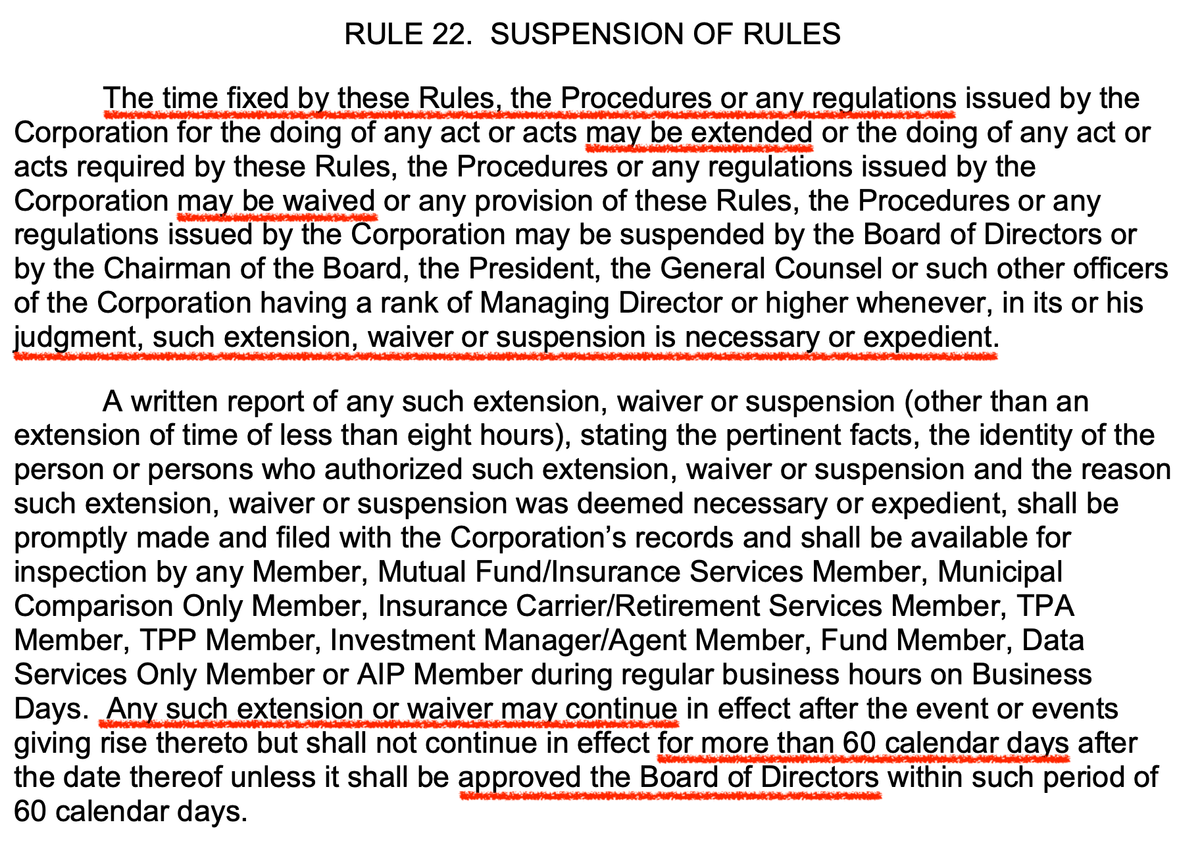Proposed Rule Change to Provide Relief Specified Option Transactions under Rule 4210 (Margin Requirements). Introduces a new exception for CME's "protected option" strategy, which applies to short option positions based on the same index option


https://public-inspection.federalregister.gov/2023-15266.pdf
- FINRA is proposing to amend FINRA Rule 4210 (Margin Requirements) to provide margin relief for specified index option transactions, known as “protected options,” and to make other minor conforming revisions with regard to the margin relief.

Wut mean?:
- The SEC has approved a proposed rule change by the Cboe Exchange regarding margin requirements for cash-settled index options written against exchange-traded funds (ETFs) that track the same index.
- The rule change introduces a new exception for a "protected option" strategy, which applies to short option positions offset by positions in an underlying stock basket, non-leveraged index mutual fund, or non-leveraged ETF based on the same index option.
- In response, FINRA is proposing to align its margin rule with the new provisions adopted by Cboe.
- When the protected option or warrant position is created, the absolute value of the protection should not be less than 100 percent of the aggregate current underlying index value associated with the protected option or warrant position. This can be determined at either the time the order that created the protected option or warrant position was entered or executed, or at the close of business on the trading day the protected option or warrant position was created.
- The absolute value of the protection should at no time be less than 95 percent of the aggregate current underlying index value associated with the protected option or warrant position.
- Margin should be maintained in an amount equal to the greater of:
- The amount, if any, by which the aggregate current underlying index value is above (below) the aggregate exercise price of the protected call (put) option or warrant position.
- The amount, if any, by which the absolute value of the protection is below 100 percent of the aggregate current underlying index value associated with the protected option or warrant.
- According to the new rule, when an index call (put) option or warrant is carried "short" (the "protected option or warrant position") and there is carried in the same account a long (short) position in an underlying stock basket, non-leveraged index mutual fund, or non-leveraged ETF (each, referred to as the "protection") that is based on the same index underlying the index option or warrant, the protected option or warrant position is not subject to the usual margin requirements if the specified conditions are met.
- The conditions include maintaining a certain level of protection (in the form of the underlying assets) and maintaining a certain level of margin. The margin is calculated based on the greater of two amounts: the amount by which the aggregate current underlying index value is above (below) the aggregate exercise price of the protected call (put) option or warrant position, or the amount by which the absolute value of the protection is below 100 percent of the aggregate current underlying index value associated with the protected option or warrant.
- This rule change allows for a new exception to the usual margin requirements for short positions in index options or warrants, provided that the short position is adequately covered by the underlying assets and the specified conditions are met.

How to Comment:
- Electronic Comments: You can submit your comments electronically in two ways:
- Use the Commission’s Internet comment form available at https://www.sec.gov/rules/sro.shtml
- Send an email to [email protected]. Make sure to include the File Number SR-FINRA-2023-010 in the subject line.
- Paper Comments: You can also send your comments in writing. Send three copies of your comment to Secretary, Securities and Exchange Commission, 100 F Street, NE, Washington, DC 20549-1090.
- Remember to refer to the File Number SR-FINRA-2023-010 in your submission, regardless of the method you choose.
- Only include information you want to be public
- Comments due by August 8th.
How could this impact GameStop?
- Theoretically, by reducing margin requirements, the rule could make it more attractive for SHF to engage in short selling strategies involving options, as they can now hold other types of assets to offset their positions.
TLDRS:
- The SEC has approved a rule change proposed by the Cboe Exchange for margin requirements for cash-settled index options written against ETFs that track the same index.
- The rule change introduces a new exception for a "protected option" strategy, which applies to short option positions offset by positions in an underlying stock basket, non-leveraged index mutual fund, or non-leveraged ETF based on the same index option.
FINRA is proposing to align its margin rule with the new provisions adopted by Cboe. The conditions for the new rule include:
- When the protected option or warrant position is created, the absolute value of the protection should not be less than 100% of the aggregate current underlying index value associated with the protected option or warrant position.
- The absolute value of the protection should at no time be less than 95% of the aggregate current underlying index value associated with the protected option or warrant position.
- Margin should be maintained in an amount equal to the greater of:
- The amount, if any, by which the aggregate current underlying index value is above (below) the aggregate exercise price of the protected call (put) option or warrant position.
- The amount, if any, by which the absolute value of the protection is below 100% of the aggregate current underlying index value associated with the protected option or warrant.
- Theoretically, by reducing margin requirements, the rule could make it more attractive for SHF to engage in short selling strategies involving options, as they can now hold other types of assets to offset their positions.



